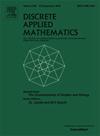Characterization of minimally t-tough, 2K2-free graphs for 1
IF 1
3区 数学
Q3 MATHEMATICS, APPLIED
引用次数: 0
Abstract
A graph is minimally -tough if the toughness of is exactly and the removal of any edge decreases the toughness. Kriesell’s conjecture, stating that every minimally 1-tough graph has a vertex of degree 2, is still open for general graphs. Katona and Varga generalized Kriesell’s conjecture that every minimally -tough graph has a vertex of degree for any positive rational number . We have confirmed Kriesell’s conjecture for -free graphs by showing that every minimally 1-tough, -free graph is or . In this paper, we prove that for , every minimally -tough, -free graph on at least 14 vertices has a vertex of degree by characterizing the structure of these graphs.
1
如果图G的韧性正好为t,并且去掉任何边都会降低韧性,那么图G就是最小t韧性。Kriesell的猜想,即每个最小1-tough图都有一个2度的顶点,对于一般图仍然是开放的。Katona和Varga推广了Kriesell的猜想,即对于任意正有理数t,每个最小t-坚韧图都有一个顶点为≤2t²。我们通过证明每个最小1-坚韧,无2k2的图都是C4或C5,证实了Kriesell关于无2k2图的猜想。本文通过刻画图的结构,证明了对于1<;t≤2,每一个至少有14个顶点的最小t-坚韧,无2k2的图都有一个顶点为≤2t;
本文章由计算机程序翻译,如有差异,请以英文原文为准。
求助全文
约1分钟内获得全文
求助全文
来源期刊
 Discrete Applied Mathematics
数学-应用数学
CiteScore
2.30
自引率
9.10%
发文量
422
审稿时长
4.5 months
期刊介绍:
The aim of Discrete Applied Mathematics is to bring together research papers in different areas of algorithmic and applicable discrete mathematics as well as applications of combinatorial mathematics to informatics and various areas of science and technology. Contributions presented to the journal can be research papers, short notes, surveys, and possibly research problems. The "Communications" section will be devoted to the fastest possible publication of recent research results that are checked and recommended for publication by a member of the Editorial Board. The journal will also publish a limited number of book announcements as well as proceedings of conferences. These proceedings will be fully refereed and adhere to the normal standards of the journal.
Potential authors are advised to view the journal and the open calls-for-papers of special issues before submitting their manuscripts. Only high-quality, original work that is within the scope of the journal or the targeted special issue will be considered.
Discrete Applied Mathematics
数学-应用数学
CiteScore
2.30
自引率
9.10%
发文量
422
审稿时长
4.5 months
期刊介绍:
The aim of Discrete Applied Mathematics is to bring together research papers in different areas of algorithmic and applicable discrete mathematics as well as applications of combinatorial mathematics to informatics and various areas of science and technology. Contributions presented to the journal can be research papers, short notes, surveys, and possibly research problems. The "Communications" section will be devoted to the fastest possible publication of recent research results that are checked and recommended for publication by a member of the Editorial Board. The journal will also publish a limited number of book announcements as well as proceedings of conferences. These proceedings will be fully refereed and adhere to the normal standards of the journal.
Potential authors are advised to view the journal and the open calls-for-papers of special issues before submitting their manuscripts. Only high-quality, original work that is within the scope of the journal or the targeted special issue will be considered.
IF 1
3区 数学
Q3 MATHEMATICS, APPLIED
引用次数: 0
Abstract
A graph is minimally -tough if the toughness of is exactly and the removal of any edge decreases the toughness. Kriesell’s conjecture, stating that every minimally 1-tough graph has a vertex of degree 2, is still open for general graphs. Katona and Varga generalized Kriesell’s conjecture that every minimally -tough graph has a vertex of degree for any positive rational number . We have confirmed Kriesell’s conjecture for -free graphs by showing that every minimally 1-tough, -free graph is or . In this paper, we prove that for , every minimally -tough, -free graph on at least 14 vertices has a vertex of degree by characterizing the structure of these graphs.
1
如果图G的韧性正好为t,并且去掉任何边都会降低韧性,那么图G就是最小t韧性。Kriesell的猜想,即每个最小1-tough图都有一个2度的顶点,对于一般图仍然是开放的。Katona和Varga推广了Kriesell的猜想,即对于任意正有理数t,每个最小t-坚韧图都有一个顶点为≤2t²。我们通过证明每个最小1-坚韧,无2k2的图都是C4或C5,证实了Kriesell关于无2k2图的猜想。本文通过刻画图的结构,证明了对于1<;t≤2,每一个至少有14个顶点的最小t-坚韧,无2k2的图都有一个顶点为≤2t;
本文章由计算机程序翻译,如有差异,请以英文原文为准。
求助全文
约1分钟内获得全文
求助全文
来源期刊

Discrete Applied Mathematics
数学-应用数学
CiteScore
2.30
自引率
9.10%
发文量
422
审稿时长
4.5 months
期刊介绍:
The aim of Discrete Applied Mathematics is to bring together research papers in different areas of algorithmic and applicable discrete mathematics as well as applications of combinatorial mathematics to informatics and various areas of science and technology. Contributions presented to the journal can be research papers, short notes, surveys, and possibly research problems. The "Communications" section will be devoted to the fastest possible publication of recent research results that are checked and recommended for publication by a member of the Editorial Board. The journal will also publish a limited number of book announcements as well as proceedings of conferences. These proceedings will be fully refereed and adhere to the normal standards of the journal.
Potential authors are advised to view the journal and the open calls-for-papers of special issues before submitting their manuscripts. Only high-quality, original work that is within the scope of the journal or the targeted special issue will be considered.
联系我们:info@booksci.cn
Book学术提供免费学术资源搜索服务,方便国内外学者检索中英文文献。致力于提供最便捷和优质的服务体验。
Copyright © 2023 布克学术 All rights reserved.
京ICP备2023020795号-1
 京公网安备 11010802042870号
京公网安备 11010802042870号
京ICP备2023020795号-1

Book学术文献互助群
群 号:604180095

 求助内容:
求助内容: 应助结果提醒方式:
应助结果提醒方式:
